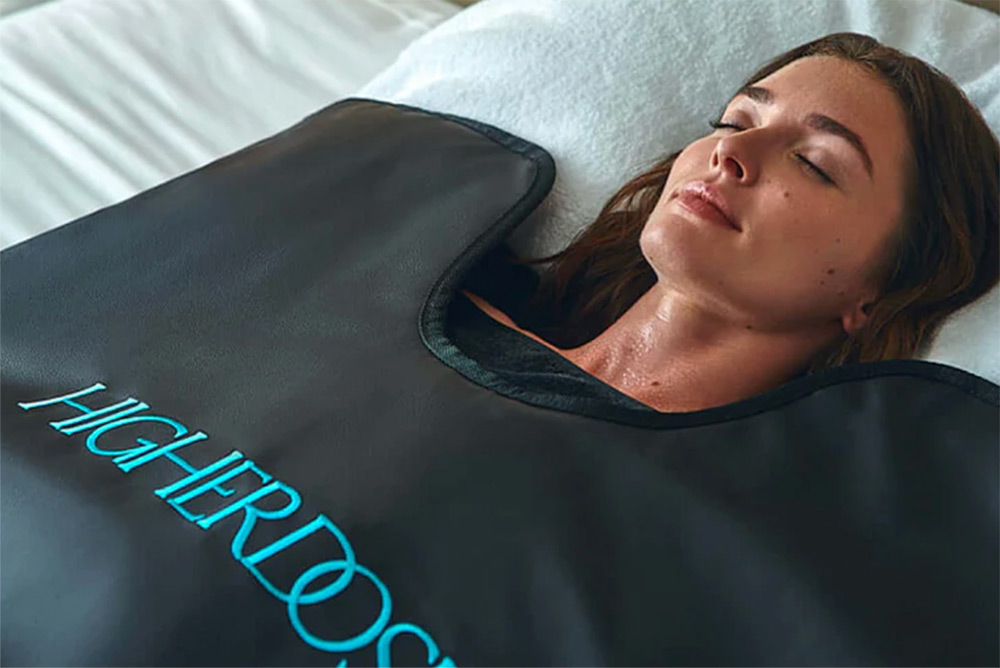
Infrared sauna blanket ($699) from Higherdose.com.
By Mary Carpenter
“A HOST of at-home infrared sauna blankets hitting the market…are the latest wellness trend to have transcended the clinic,” writes Roberta Schroeder in British Harper’s Bazaar. Like the original free-standing infrared sauna cabins, these “body-warming cocoons” not unlike sleeping bags purport to treat everything from knee pain and mood disorders to heart failure—with most users reporting relaxation, reduced anxiety and improved sleep.
Infrared saunas have long been popular in Japan, called “Waon therapy,” with good results treating chronic heart failure—and more recently, chronic fatigue syndrome. While “wet” Finnish-style saunas heat the air from 180-200 degrees to create intense sweating, “dry” infrared saunas that can be set between 100-140 degrees use light—electromagnetic radiation— to warm the body directly. (In contrast to far-infrared waves used in sauna cabins and blankets, near-infrared or red light has different effects that may help with retinal diseases and cosmetic rejuvenation.)
For both dry and wet saunas, a meta-analysis by Melbourne biomedical researchers that involved almost 4,000 patients found “heat stress causes significant sweating that is likely to lead to…beneficial cardiovascular and metabolic effects.”
Infrared blankets range from cheaper models under $150 to those costing thousands—on Amazon and elsewhere—depending on the material and add-on features such as “sweat-absorbing inserts,” with the general advice to buy more than one. Commented one Amazon buyer, “I thought there was a soft inside to this. There isn’t. It’s more like crawling into a zip lock bag then putting yourself in the microwave for twenty minutes. You come out dripping wet, feeling gross and usually cold.”
“You’ll want to watch out for any burns or signs of dehydration,” according to Kerry Martin, exercise physiologist at the health technology company Biostrap. Martin suggests “drinking lots of water and replenishing your electrolytes after each session.” Most experts advise consulting a physician before buying an infrared sauna blanket.
“Individuals with heart conditions should avoid all sauna therapy,” according to medicalnewstoday—albeit based on anecdotal reports. Also with “minimal evidence,” the blankets may benefit blood circulation and metabolism, burn fat and calories and accelerate detoxification.
Far-infrared frequencies penetrate deeper into the body compared with wet saunas, causing greater dilation of blood vessels and capillaries that could decrease inflammation and remove toxins throughout the body. Compared to sweating from exercise, infrared supporters assert that sweat produced in these saunas works better to evacuate body toxins and metabolic waste.
The “most far-reaching assertions for this [infrared sauna] technology center on detoxification,” writes Gary Stix for Scientific American. But, noted USC pharmaceutical sciences professor Roger Clemens, “the most efficient system” for detox is the kidneys, liver, GI tract and the immune system: “Except when one of the major organs breaks down, there isn’t a medical device…that can accelerate the body’s natural process of detoxification.”
And for the best evidence-supported effects of infrared sauna blankets—boosting mood, reducing blood pressure and enhancing circulation—studies have been small. An international literature review of more than 200 research papers, however, found infrared therapy decreased pain levels in patients suffering from musculoskeletal disorders—in particular, knee osteoarthritis—and in those diagnosed with fibromyalgia. The review labeled “debatable” any effects on low back pain and muscle damage from sports injuries.
For my only experience with infrared sauna, recommended by a physical therapist, I hoped to alleviate lingering effects of Lyme disease—on the theory that infrared light kills off endotoxins released by Lyme-causing spirochetes, which can remain in the body after antibiotics kill off the bugs themselves.
In a cabin-style infrared sauna, my main impression was: very hot! I was unable to go much above 125 degrees F without opening the door and fanning in cooler air. But the main drawback was my struggle to get comfortable for 45 minutes on a hard seat that was too short for lying down—and, compared to traditional saunas, I sweated less and thus felt less cleansed.
As with most alternative or complementary therapy options I have tried—acupuncture, myofascial release therapy, flotation therapy—health benefits require more than a one-time try. For detoxing from infrared saunas, the recommendation is once or twice a week in four-to-15-minute sessions—to avoid mobilizing too many toxins at once.
Hence, the allure of infrared sauna blankets that can be used at home. I have thought about giving one to a family member who struggles with stress and anxiety but hesitated after reading Amazon buyers’ complaints, including one that said her blanket burned and then melted (although the manufacturer’s response persuaded her to raise her rating). Most comments, however, rave about the beneficial relaxation and stress relief.
In a physical therapy session, on the other hand, I had a comfortable and pleasantly warming experience of infrared therapy lying on a Biomat—a body-length pad that produces infrared light via amethyst crystals. The cost is daunting, with brand-name Biomats close to $2,000 —though perhaps justifiable compared to the number of therapy sessions that might be needed to achieve similar, ongoing effects.
—Mary Carpenter regularly reports on topical subjects in health and medicine.
